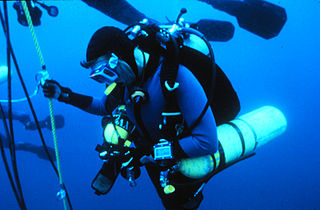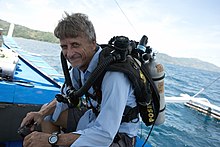In-water recompression (IWR) or underwater oxygen treatment is the emergency treatment of decompression sickness (DCS) by returning the diver underwater to help the gas bubbles in the tissues, which are causing the symptoms, to resolve. It is a procedure that exposes the diver to significant risk which should be compared with the risk associated with the available options and balanced against the probable benefits. Some authorities recommend that it is only to be used when the time to travel to the nearest recompression chamber is too long to save the victim's life, others take a more pragmatic approach, and accept that in some circumstances IWR is the best available option. The risks may not be justified for case of mild symptoms likely to resolve spontaneously, or for cases where the diver is likely to be unsafe in the water, but in-water recompression may be justified in cases where severe outcomes are likely if not recompressed, if conducted by a competent and suitably equipped team.

The banded angelfish, also known as the bandit angelfish and three spine angelfish, is a distinctive species ray-finned fish belonging to the family Pomacanthidae. It is endemic to deeper reefs in Hawaii and the Johnston Atoll.

Pomacanthus asfur, the Arabian angelfish, is a species of marine ray-finned fish, a marine angelfish belonging to the family Pomacanthidae. It is found in the Western Indian Ocean.
Neville Coleman OAM was an Australian naturalist, underwater nature photographer, writer, publisher and educator.

Chaetodontoplus meridithii, the Queensland yellowtail angelfish, Meredith's angelfish or yellow-finned angelfish, yellowtail angelfish, is a species of marine ray-finned fish, a marine angelfish belonging to the family Pomacanthidae. It is found off eastern Australia.

Centropyge heraldi, the yellow angelfish or Herald's angelfish is a species of marine ray-finned fish, a marine angelfish belonging to the family Pomacanthidae. It comes from the Pacific Ocean that sometimes makes its way into the aquarium trade.
Petroscirtes pylei, the twilight fangblenny, is a species of combtooth blenny found in the western central Pacific ocean, around Fiji. This species reaches a length of 4.1 centimetres (1.6 in) SL. The specific name honours the American ichthyologist Richard L. Pyle of the Bishop Museum in Honolulu.

Centropyge fisheri, the orange angelfish, whitetail angelfish, damsel angelfish, yellowtail angelfish, Hawaiian flame angelfish, Fisher’s angelfish, Fisher’s dwarf angelfish or Fisher’s pygmy angelfish, is a species of marine ray-finned fish, a marine angelfish belonging to the family Pomacanthidae. It is found in the Indo-Pacific region.
Onuxodon is an Indo-Pacific genus of pearlfishes from the family Carapidae. The generic name is derived from the Greek onyx meaning "claw" and odon meaning "tooth", referring to the sharp fang like teeth of Onuxodon parvibrachium. Species in this genus are distributed from South Africa to Hawaii. They live commensally with molluscs. The three currently recognized species are:
Gerald Robert "Gerry" Allen is an American-born Australian ichthyologist. His career began in 1963, when he spent a semester at the University of Hawaii, where he also received a PhD in marine zoology in 1971. In 1972, Allen wrote his doctoral thesis on the systematics and biology of the anemone fish.

Cirrhitops is a genus of marine ray-finned fish, hawkfishes from the family Cirrhitidae. They are found on tropical reefs of the Indian Ocean and the Pacific Ocean.
John Ernest "Jack" Randall was an American ichthyologist and a leading authority on coral reef fishes. Randall described over 800 species and authored 11 books and over 900 scientific papers and popular articles. He spent most of his career working in Hawaii. He died in April 2020 at the age of 95.

The peppermint angelfish is a relatively small species of marine ray-finned fish, a marine angelfish belonging to the family Pomacanthidae. It is found in the Central area of the South Pacific Ocean, and is known to be native to the Cook Islands.
Jean-Pierre Gosse was a Belgian biologist and ichthyologist.

The bluestripe butterflyfish or blue-striped butterflyfish is a species of butterflyfish found in the waters surrounding the Hawaiian Islands. The fish is endemic to Hawaii where it is common on shallow water reefs.
The Ebbe Nielsen Prize was an international science award made annually between 2002 and 2014 by the Global Biodiversity Information Facility (GBIF), to recognize a researcher who had made substantial contributions to the field of biodiversity informatics. The prize was established in memory of prominent entomologist and biodiversity informatics proponent Ebbe Nielsen, who died of a heart attack in the U.S.A. en route to the 2001 GBIF Governing Board meeting.

A Pyle stop is a type of short, optional deep decompression stop performed by scuba divers at depths well below the first decompression stop mandated by a conventional dissolved phase decompression algorithm, such as the US Navy or Bühlmann decompression algorithms. They were named after Richard Pyle, an American ichthyologist from Hawaii, who found that they prevented his post-dive fatigue symptoms after deep dives to collect fish specimens.

Louis Marie-Auguste Boutan was a French biologist and photographer. He was a pioneer in the field of underwater photography.
The Ebbe Nielsen Challenge is an international science competition conducted annually from 2015 onwards by the Global Biodiversity Information Facility (GBIF), with a set of cash prizes that recognize researcher(s)' submissions in creating software or approaches that successfully address a GBIF-issued challenge in the field of biodiversity informatics. It succeeds the Ebbe Nielsen Prize, which was awarded annually by GBIF between 2002 and 2014. The name of the challenge honours the memory of prominent entomologist and biodiversity informatics proponent Ebbe Nielsen, who died of a heart attack in the U.S.A. en route to the 2001 GBIF Governing Board meeting.
Phillip Clarence Heemstra was an American-South African ichthyologist. He was born in Melrose Park, Illinois, United States as the son of Clarence William Heemstra and his wife, Lydia. He attended school in Ottawa, Illinois, and completed a B.Sc. Zoology in 1963 at the University of Illinois at Urbana, Illinois, as well as his MSc degree (1968) and doctorate (1974) in marine biology at the University of Miami in Miami, Florida. He moved to live in South Africa in 1978.










